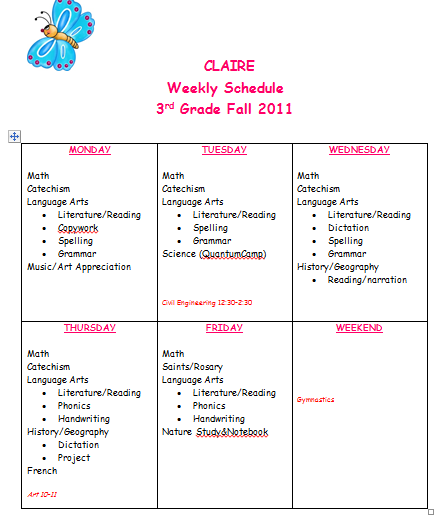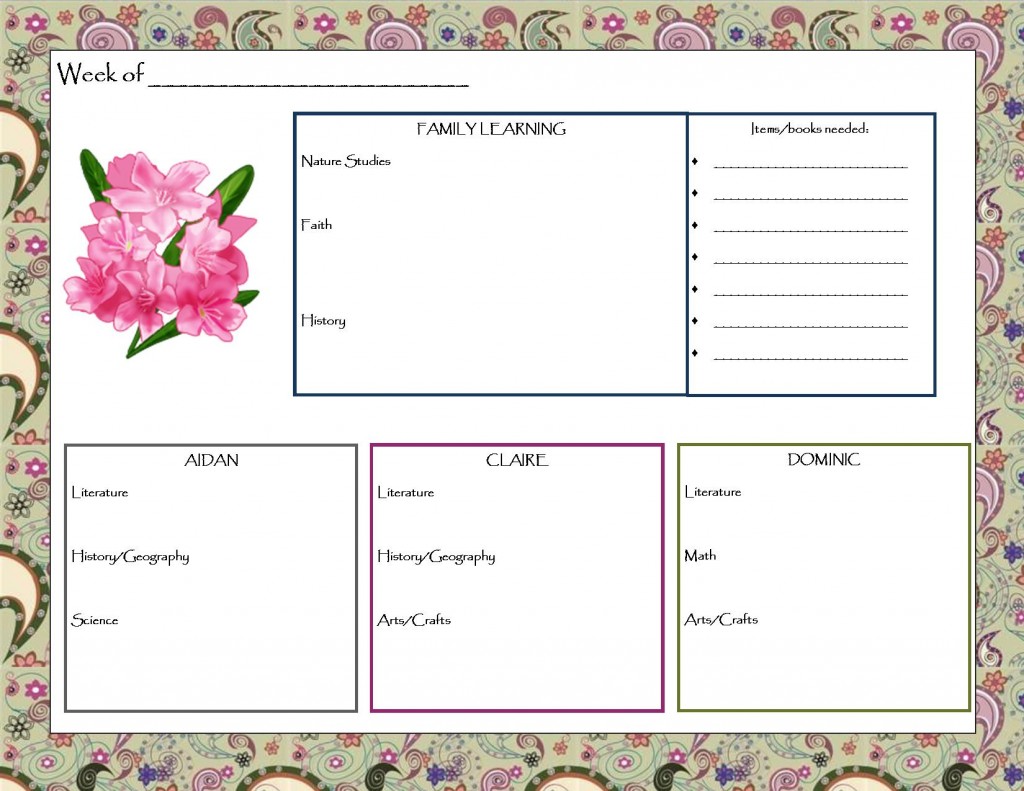In my last post I talked about the importance of clarifying your vision for your family’s homeschooling journey. Armed with this clarity, we can plan our homeschooling year to reflect our dreams, principles, and ideals.
When we first started homeschooling, I very closely followed the neo-classical curriculum advice set out in the book The Well-Trained Mind by mother-daughter team Jesse Wise and Susan Wise Bauer. My annual planning mostly involved making a curriculum list for Aidan (who was my only school-age child then) and a weekly schedule that set out which subjects we’d study on which days.
Fast forward nine years and things are very different.
I’ve transitioned to a much more Charlotte Mason-inspired approach for my younger children (and a somewhat eclectic approach for the oldest Aidan which includes many Classical elements). My opinions about how children best learn have changed and I’m very focused on the emotional atmosphere that’s necessary for optimal learning, something central to Mason’s approach. I’ve also become confident in picking and choosing from available resources to tailor our learning experience as a family.
I put together our curriculum myself every year, a process which I find challenging and delicious! I select the books for every subject, and I’ve customized my curriculum plan so that in science, history, and religion much of our learning is family-centered (all of us learning and reading together with some additional assignments for the two oldest children) and the other subjects are customized for each child depending on their interests and needs. My children each thrive much better this way and I enjoy it immensely.
However, with three of my four children now school-age, I have to keep my ducks in a row. I’ve developed a process for planning my year that’s working really well. If you’re on the independent spectrum of homeschooling or you’re just looking for a way to organize your homeschooling records, you may find these tips helpful. Each of the topics below comprises a separate tabbed section in my homeschool planner, a crisp white binder which I update annually:
1. LONG-TERM GOALS:
For my oldest son Aidan, who is nearly 14, I’ve created a long-term goals chart that outlines what he’ll be studying each year in each subject area until he graduates high school. It’s just a simple grid chart with school year going down the left side and subject areas spanning across the top. I change the chart every year because quite frankly I change my mind every year about what we’ll be doing! Aidan’s opinions and talents have a great influence on these plans and these factors of course change over time. I don’t have this kind of detailed long-term plan for my younger children, but some parents might find comfort in doing so.
2. CURRICULUM LISTS:
For each child, I create a list of the curriculum I’m using in each subject area, including a literature list whether family read-aloud or silent reading. These lists are especially useful in July & August when my curriculum orders start coming in from multi-various vendors and I need to ensure I have everything I need for each child. I also record the book selections for my family learning blocks on these lists.
These curriculum lists are like anchors when I become lost in the chaos and busy-ness during the year and forget the beautiful & inspiring books I hoped to share with my babies. You can also refer to these lists in later years when you’re making plans for younger siblings.
3. WEEKLY SCHEDULE:
In my home, we only do science and history 2 days a week, spelling 3 days a week, handwriting 2 days a week (except for Aidan who doesn’t do handwriting but does composition 5 days a week), literature and math 5 days a week (except a kindergartner in my home who only does math 2 days a week), plus the complexities of individual co-ops, music lessons, gymnastics, etc. Well, it could become maddening.
So every year I create a separate weekly schedule for each child that lists which subject they should work on each day and what sort of extra-curricular activities they’re committed to each day. I hang these lists in my kitchen (next to each child’s chore chart) and keep a copy in my homeschool binder. Here’s Claire’s schedule from Fall 2011:
4. YEAR AT A GLANCE:
Armed with my curriculum lists, I can begin to fill in my Year-at-a-Glance planner on which I record 1) liturgical feasts and saints days that I want to include in my learning plan, 2) birthdays and anniversaries, 3) holidays, and 4) any learning blocks that I’m planning with the children in my family study areas of history, faith, and science.
As Catholic Christians, liturgical feasts and celebrations are the most important entry on our calendars. Catholic devotions and holy observances can become part of our family identity if we incorporate them into our daily living plans. In this way, our Catholic Faith becomes not just what our children do, but it becomes who they are. So grab your Catholic calendar and plug in any dates that you want to share with your kids. Note: I don’t write in all the feasts and saints days; just the ones I am planning to highlight in our home.
I keep this Church celebrations and holidays chart in my planning binder: it contains the major liturgical feasts and any secular holidays for each month in snapshot format, so I can see quickly what is coming up. I refer frequently to this handy chart all year as I’m thinking about the few months ahead. I update movable dates every year.
Learning blocks are topics I’m covering with at least two of my children together. I might be teaching 4 weeks on the Civil War or 6 weeks on Beatrice Potter books. So in my Year-at-a-Glance planner I’ll pencil in these blocks in the month I’m planning to begin them along with a notation regarding the number of weeks we’ll be spending on the learning block.
Here’s a copy of my Year at a Glance planner. Note: I never know everything I would need to know to fill in this planner for the entire year. I tend to fill in the liturgical feasts we celebrate every year and the learning blocks I have planned for the first semester, then as the year progresses I’ll fill in the Year-at-a -Glance 3 to 4 months ahead of time.
5. WEEKLY PLANNER:
This is my most powerful resource as a do-it-yourself homeschooler. I use it more than any other resource. I’ve created this lovely snapshot weekly planner sheet for my family. Each sheet has a space for family learning topics, a box for each of my 3 school-age children, and a space to write down resources I need to get from the craft store or library to prepare for that week. I print out 3 to 4 sheets at a time which allows me to plan ahead 3 to 4 weeks for the whole family.
Each sheet gives me a week’s snapshot of what I’m doing with the whole family and also some selected subjects for each child – these subjects are the ones that take a little more planning on my part. For example, spelling is very easy – the kids just move on to the next lesson each week. I don’t have these on my weekly planner. But in history, we do some reading together, and the older 2 kids shave individual selections they’re responsible for. Dominic has a standard math curriculum now, but I also do creative projects with him in math every week (like making numbers out of the items we find in nature). So on this planner, I can record all that. By filling out 3 or 4 weeks ahead of time, I feel well prepared every week.
Here are some blank weekly planners for families with two, three, or four children.
Kim’s Weekly Planner 2 Children
Kim’s Weekly Planner 3 Children
Kim’s Weekly Planner 4 Children
And for those of you blessed with bunches of babies or who just want an extra planning sheet, here’s a supplemental page with 6 blank boxes:
6. LEARNING LOGS:
Some families like to keep track of what their kids do every day or week in each subject. This is too much detail for me. However, because I homeschool my younger kids through a charter school I’m required to turn in summaries of what they’ve learned each month and an attendance sheet. So I create summaries every month. I have master charts that I use each month and just fill in as I go along. Each summary is obviously customized and coordinated with what the particular child is studying. I usually make messy notes in pencil all month then retype everything before our charter’s learning coordinator comes. When Aidan is in high school I’ll probably keep very detailed notes for him too but that’s a year away!
I’m currently redesigning this chart for the coming year so I’ll put it up when it’s ready, but it’s a simple grid chart listing each subject along with columns for resources used & what we did.
As I said, each of these six tools comprises a separate tabbed section in my homeschool binder. I keep them in this order from front to back:
- Learning logs
- Weekly schedules
- Blank weekly planners (the ones I’m working with are stapled together and kept with the current week facing out in the see-through pocket on the back of my binder so that I can see it quickly throughout the day).
- Curriculum lists
- Year at a Glance
- Long-Term Planning
I also keep copies of the children’s old curriculum lists in a pocket in my binder so that I can recall what I’ve read them in previous years, but this is also in my computer so if my binder ever gets too bulky I can get rid of these.
I’ve seen very elaborate homeschool planners that have just about everything you can imagine in them, including menu planning, chore charts, and medical appointments. I can definitely see the appeal of these systems to busy homeschooling parents, but there always seems to be some element I don’t’ like and they’re hefty things! I prefer to have a separate resource to keep track of these other things.
I use a small commercial planner in which I enter family medical appointments, playdates, and my menu plans every week. I use this one published by family-centered.com; I like it because it includes the Church feasts and saints days and it’s small enough to fit in my purse. Chore charts are hung on the kitchen wall next to the kids’ daily school schedules.
All of this helps me feel like I know what’s going on, but I drop it all in a moment if there’s a birds nest to view, a beautiful day calling us lake side, or if we’re all too tuckered out to do much but sit around talking and listening to piano music!


